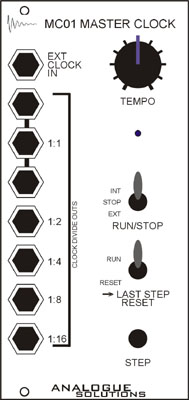| Module |
Controls & Ins/Outs |
 |
MC01 Master
Clock with Dividers
Inputs: External Clock In
Outputs:
3x clock outputs (divider by 1)
divide by 2
divide by 4
divide by 8
divide by 16
Power: +/-12V, 5V
Controls:
Tempo knob (speed)
Run/Reset toggle switch:
Internal (start), External (start), centre off (stop) toggle switch.
Step momentary push button.
Indicators: 1:1 clock pulse LED
Size:12HP |
Details
The master clock is a clocking module to provide timing for
a number of sequencers. It also features built in clock dividers. An external clock can be
used instead and fed through the dividers. Another unique feature is the master reset
switch. This not only resets the internal clock dividers, but when appropriately connects
(via internal leads), will reset the FS01 Fill-In module and also reset all Concussor
analogue sequencers to the last step (see note below). The MC01 step button will also step
all sequencers with its own step button (when connected to the clock input of each
module).
By combining the clock and divider, important clock
features are brought together in one convenient module, whilst also saving money. The
clock frequency will only run in a fairly standard tempo rate range as this module is
intended for use as a sequencer clocking device. It will not run into audio range like
some LFO's.
When the reset button is pressed on most analogue
sequencers, the sequencers resets itself to step 1. The problem with this is that when the
sequencer is started, it actually starts on step 2. This is because when it receives its
first clock pulse (either from the internal clock or from external sources), the sequencer
advances one step (to step 2), the generates the appropriate Gate and CV (as stet at step
2). It does not generates the appropriate Gate and CV (as stet at step 1) then advance to
step 2. This is completely useless as when you start a sequencer you want it to start on
step 1, not 2. The way to avoide this is to manually stepp all your sequencers to the last
step of the pattern (ususally 8 or 16, on 8 or 16 step sequencers respectively). That is
why our sequencers can automatically be reset to the LAST step, so that when the clock is
started, the sequencer does in fact start with step 1.
Use
Take one of the clock outputs and patch it into the clock
input of a sequencer. Any of the outputs can be used to gate or trigger synth's or
percussion modules. If preferred, and external clock can be used for control, e.g. a clock
pulse from a MIDI-CV converter.
When using a pretty standard (in analogue sequencers) 4ppqn
pulse rate, the divide outputs give:
1:1 16th notes
1:2 8th notes
1:4 ¼ notes
1:8 ½ notes
1:16 Whole notes
When using any of the clock divide outputs (/2
/4 /6 /8 /16), the MC1 must be reset each time before starting.
Other Uses
Use, for example, divide by 4 output to trigger straight
4/4 kick drum pattern. Likewise use the 1:1 clock output to trigger 16th note
hihats.
